This post is long overdue, I finished version 2 of these speakers a few years ago.
But finally here's the post 🙂
Let me present the version 2 of my RefSpeaker.
All the little annoyances of V1 are fixed, I don't think there will be a version 3 😉
I used the same drivers but with updated cabinets and crossover.
Here's a list of the updates compared to V1:
Specs:
sensitivity: 93db
Freq range: 25-20000Hz
Impedance: 4ohm
Dimensions (WxDxH): 35x52x130cm
Weight: a lot
Drivers (same as in V1):
Raal 140-15DAM amorphous core
Accuton C173-6-090
Alcone AC10HE (two in parallel)
Cabinets:
Separated bass and mid/high cabinets: acoustically decoupled with Sylomer SR110
Cabinets are made of 18mm birch multiplex.
Bass Cabinet:
The bass cabinet is about 115 liters with plenty of bracing and a double/triple front-panel made of 36-50mm birch.
As damping material I used 1-2cm felt on all panels, basotect(pyramid 8cm) on the back and top-bottom.
Bass-reflex pipe is at the bottom, 8cm diameter and 8cm long, tuned for 24Hz.
Cabinet feet are Soundcare superspike with additional Sylomer SR110 pads (0.7kg/cm²)
Mid Cabinet:
The mid cabinet is a 10 liter aperiodic vented cone shaped box, optimized for backwave absorption.
As damping material: 1cm felt on all panels, inside volume completely stuffed with Twaron Angelhair (3gr/l).
Crossover:
The crossover is fairly simple:
3rd order electrical on the woofers to suppress the breakup of the cones, notch LCR on impedance peak (switchable on/off)
2nd order electrical on the mid, no need for pad-down resistors, sensitivity mid matches the parallel woofers + BSC
3rd order electrical on the Raal ribbon.
Crossover points at 230Hz and 3000Hz.
Minimal impedance: 3.5ohm
The quality of the crossover components is important with these drivers, give it crap and you will hear it.
For the woofers I used coils with the lowest possible resistance/distortion: Mundorf MCoil CFS10 iCore (StackCore) 3,9mH + Mundorf L300 0.82mH
The Accuton mid has 12AWG Jantzen wax coil and as caps Mundorf Supreme EVO Oil 47uf + K71-4 polystyrene 3x10uf + Audyn reference 11uf.
For the Raal ribbon I used Audyn reference caps, bypassed with Audyn true copper caps + silver mica, as resistors Isabellenhütte PBH.
What makes these speakers standout is their holographic presentation, excellent separation,
it's like the distances between the lows, mids and highs (instruments,voices) have been pulled out, opened up.
It's easy to hear the differences in soundstage(depth) of different amplifiers, for now the Alpha Nirvana 39 is king 🙂
Regards,
Danny
But finally here's the post 🙂
Let me present the version 2 of my RefSpeaker.
All the little annoyances of V1 are fixed, I don't think there will be a version 3 😉
I used the same drivers but with updated cabinets and crossover.
Here's a list of the updates compared to V1:
- the bass cabinets went from 80 to 115 liter, gives better lower bass and more 25-40Hz output.
- more bracing in the bass cabinets
- the bass reflex pipe went from the bottom near back to bottom near front,
it's 7.5cm diameter and 8cm long, this puts the tuning freq low at 24Hz - For the mid cabinets I went from a 3.5 liter closed box to a 10 liter aperiodic vented cone shaped box, this made a huge update to the sound:
with the small closed box in the V1 I didn't get the Accutons C173-6-090 to sound completely good, sometimes it sounded nasal, congested,
I suspect it was due to the backwaves of the cone bouncing around in the small closed box.
with the new 10 liter cone shape tapered box (45cm long), the backwave is completely absorbed, also thanks to the phenomenal Twaron Angelhair (stuffed 3gr/l), recommended !
Now it sounds much more natural, open and dynamic.
Inspiration for the larger cone shaped mid comes from Troels, the venturi vent in the Avalon clone and XTZ divine.
My findings correspond to those from Troels, see halfway "Mid cab vent", - better decoupling between the cabinets and the floor with Sylomer SR110 (0.7kg/cm²), recommended !
- crossover between woofers and mid a little higher, so the Accuton mid is freed more from the 100-200 Hz duties
- higher minimum impedance
- notch filter on woofers to suppress the first impedance peak, gives more equal bass ouput (optional, added switch)
- better phase integration between mid and ribbon, xo point remains at constant height at different distances.
- better cabinet damping, the bass cabinet has felt(1.5cm) on all sides and basotect(pyramid 8cm) on the back and top-bottom, the backside an additional 10cm twaron(4gr/l).
The sandwich felt, Basotect, Twaron works great! - Nicer looks with two components polyester paint, 5 layers, lots of work, but great looks 🙂
Specs:
sensitivity: 93db
Freq range: 25-20000Hz
Impedance: 4ohm
Dimensions (WxDxH): 35x52x130cm
Weight: a lot
Drivers (same as in V1):
Raal 140-15DAM amorphous core
Accuton C173-6-090
Alcone AC10HE (two in parallel)
Cabinets:
Separated bass and mid/high cabinets: acoustically decoupled with Sylomer SR110
Cabinets are made of 18mm birch multiplex.
Bass Cabinet:
The bass cabinet is about 115 liters with plenty of bracing and a double/triple front-panel made of 36-50mm birch.
As damping material I used 1-2cm felt on all panels, basotect(pyramid 8cm) on the back and top-bottom.
Bass-reflex pipe is at the bottom, 8cm diameter and 8cm long, tuned for 24Hz.
Cabinet feet are Soundcare superspike with additional Sylomer SR110 pads (0.7kg/cm²)
Mid Cabinet:
The mid cabinet is a 10 liter aperiodic vented cone shaped box, optimized for backwave absorption.
As damping material: 1cm felt on all panels, inside volume completely stuffed with Twaron Angelhair (3gr/l).
Crossover:
The crossover is fairly simple:
3rd order electrical on the woofers to suppress the breakup of the cones, notch LCR on impedance peak (switchable on/off)
2nd order electrical on the mid, no need for pad-down resistors, sensitivity mid matches the parallel woofers + BSC
3rd order electrical on the Raal ribbon.
Crossover points at 230Hz and 3000Hz.
Minimal impedance: 3.5ohm
The quality of the crossover components is important with these drivers, give it crap and you will hear it.
For the woofers I used coils with the lowest possible resistance/distortion: Mundorf MCoil CFS10 iCore (StackCore) 3,9mH + Mundorf L300 0.82mH
The Accuton mid has 12AWG Jantzen wax coil and as caps Mundorf Supreme EVO Oil 47uf + K71-4 polystyrene 3x10uf + Audyn reference 11uf.
For the Raal ribbon I used Audyn reference caps, bypassed with Audyn true copper caps + silver mica, as resistors Isabellenhütte PBH.
What makes these speakers standout is their holographic presentation, excellent separation,
it's like the distances between the lows, mids and highs (instruments,voices) have been pulled out, opened up.
It's easy to hear the differences in soundstage(depth) of different amplifiers, for now the Alpha Nirvana 39 is king 🙂
Regards,
Danny
Attachments
Last edited:
Construction pictures of the bass cabinets with plenty of bracing and 36-50mm thick front.
Attachments
Excellent work,
Impressive bracing. You must be thrilled with the sound?
Impressive bracing. You must be thrilled with the sound?
Thanks!
Yes, they really sound good, luckily after all that work 😀
Yes, they really sound good, luckily after all that work 😀
Hi! sincere congratulations for your excellent creation and thank you for sharing all these valuable information
you say that the dips below 300Hz are room related i guess that being very narrow they have no impact on the overal performance ?
you say that the speakers are great at generating a 3d soundstage Do you use any specific track to test this aspect ?
i am obsessed by sound image For me it is decisive
you say that the dips below 300Hz are room related i guess that being very narrow they have no impact on the overal performance ?
you say that the speakers are great at generating a 3d soundstage Do you use any specific track to test this aspect ?
i am obsessed by sound image For me it is decisive
If you move the microphone or the speakers, the measurements below 500Hz will also change, the dips can become peaks and vice versa.
Especially between 100 and 300Hz the dips are the floor bounce cancellations at the microphone position.
To get a better idea of the indoor bass you can do RTA measurements in REW and move around with the microphone.
Not a specific track, but a rather long list of test tracks that I have, see the attachment
Especially between 100 and 300Hz the dips are the floor bounce cancellations at the microphone position.
To get a better idea of the indoor bass you can do RTA measurements in REW and move around with the microphone.
Not a specific track, but a rather long list of test tracks that I have, see the attachment
Attachments
Last edited:
Thank you very much Very interesting I guess that the dips should be less harmful than peaks Like omissions are less bad than unnatural peaksIf you move the microphone or the speakers, the measurements below 500Hz will also change, the dips can become peaks and vice versa.
Especially between 100 and 300Hz the dips are the floor bounce cancellations at the microphone position.
To get a better idea of the indoor bass you can do RTA measurements in REW and move around with the microphone.
I see no peaks at all Good and the mid to high range looks perfect
Thanks a lot again I have finally understood the importance of tracks for system evaluationNot a specific track, but a rather long list of test tracks that I have, see the attachment
Expecially to evaluate particular performance as 3d soundstage
personally i have often used the track "Walkaround" in this test CD (with usually bad results)
i found another one
Last edited:
Beautiful work.Construction pictures of the mid cabinet with the aperiodic vent.
The tapered back of the midrange cabinet is very interesting. I wanted to ask, is material lining the inside of the midrange enclosure flooring underlay? I find F-7 to F-11 wool mix felt is difficult to source.
It's felt that I bought in a car shop,
that felt is quite commonly used for sound absorption in cars.
I have used it in 1cm thickness for the mid, and in 2cm thickness for the bass cabinet.
It resembles to the Jantzen Audio damping felt
But the most effective damping for the mid is Twaron Angel hair, you only need 3 to 4grams/liter
The whole mid cabinet is filled with it, about 30grams for the 10 liter.
that felt is quite commonly used for sound absorption in cars.
I have used it in 1cm thickness for the mid, and in 2cm thickness for the bass cabinet.
It resembles to the Jantzen Audio damping felt
But the most effective damping for the mid is Twaron Angel hair, you only need 3 to 4grams/liter
The whole mid cabinet is filled with it, about 30grams for the 10 liter.
Last edited:
Hi did you glue more layers of birch together ?a double/triple front-panel made of 36-50mm birch.
Which glue did you use?
Thank you
I used a common wood glue: Bison D3
The surfaces to glue can not be big, because you won't be able to put enough pressure everywhere on large surfaces.
With the frontpanel it was possible because the surfaces to glue are rather small thanks to the cutouts of the woofers, largest surfaces are 5-10cm wide.
Also above and below the woofers there are cutouts on the innerpanel to make it easier when gluing the frontpanel.
See the 4th picture in the bass cabinet: the frontpanel on the ground is later glued on the standing cabinet on the right.
The surfaces to glue can not be big, because you won't be able to put enough pressure everywhere on large surfaces.
With the frontpanel it was possible because the surfaces to glue are rather small thanks to the cutouts of the woofers, largest surfaces are 5-10cm wide.
Also above and below the woofers there are cutouts on the innerpanel to make it easier when gluing the frontpanel.
See the 4th picture in the bass cabinet: the frontpanel on the ground is later glued on the standing cabinet on the right.
- Home
- Loudspeakers
- Multi-Way
- My RefSpeaker V2
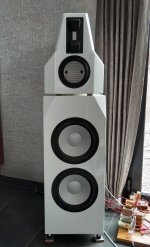
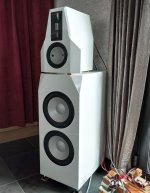
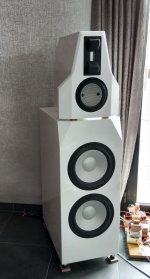
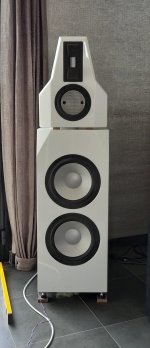

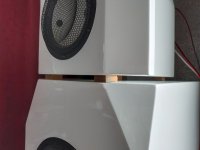
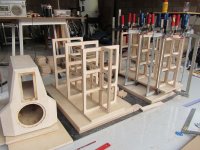
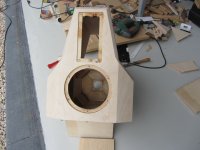
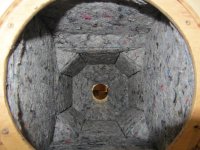
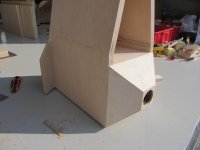
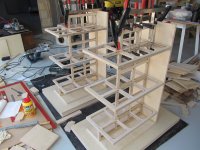
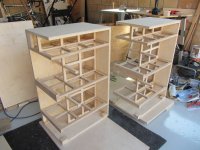
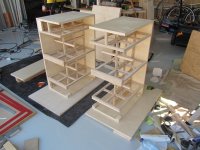


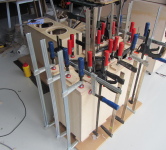
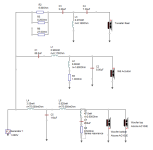

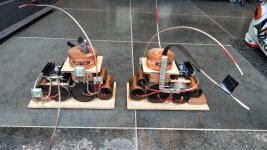
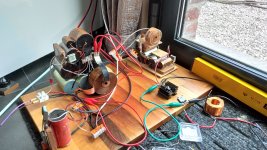
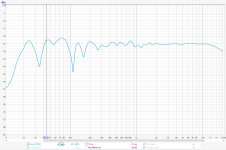
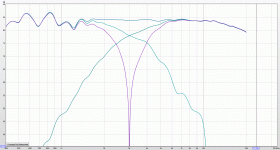
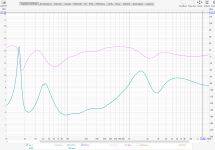
 Wish I had your patience!
Wish I had your patience! 